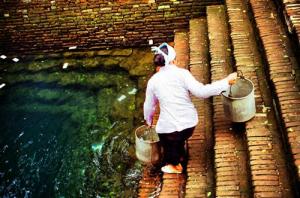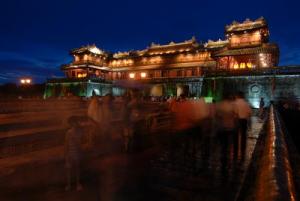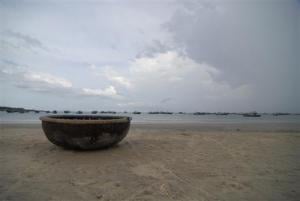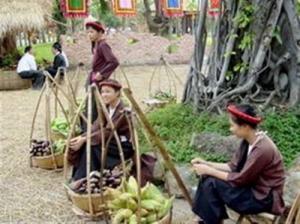Thousand-Year Old Legend Lives on in Bac Ninh Province

Nestled along the Red River Delta on the north of Vietnam is the tiny province of Bac Ninh. Known as among the culturally-rich parts of the country, and home to the popular Vietnamese Quan Ho folk music, Bac Ninh also cradles thousand-year old living legends which for a long time now, have played a huge role in the locals’ daily lives.
In Diem Village, Hoa Long Commune of Bac Ninh town, the known heart of the province, a well that has been dug from over a thousand years ago nourish residents with its sweet and cool water. Built with and surrounded by 11 brick steps descending to four stone steps and a final wooden step to allow easy reach to the water enclosed, the Ngoc (Gem) Well is where locals draw water for consumption, to make tea, alcoholic beverage or any other forms of drink. How it had become a great part of the residents’ day-to-day activities had stirred the interest and curiosity of many visitors from other parts of Vietnam and even from across the globe. Thus, many tourists travel all the way to this humble town to draw a cupful and discover for themselves what makes its water and the well itself very special.
The water Ngoc Well holds come from several springs in the Kim Son and Kim Linh mountains. According to the locals, regardless the season or climate, the well’s water levels remain unchanged at six meters. But another reason that makes Ngoc Well very significant is it also happens to be home of three scale-less fishes that appear like carps. The two black fishes adorned with scattered red spots around its body are believed to be incarnations of princesses Tien Dung and Thuy Tien, daughters of King Ly Thanh Tong, while the third fish, black in color with several black spots is said to be their servant.
Legend has it that the then Queen Thuong Dong once dreamt of two holy carps who spoke to her in her sleep, telling her of their desire to be reincarnated as her daughters. It wasn’t long after the queen had that strange dream when she indeed got pregnant and gave birth to two beautiful and intelligent girls who both had very pure hearts. When the two princesses grew older, they asked the King to let them to head off the Kim Linh Mountain where they bravely fought dangerous beasts who harmed the villagers. Not only the two princesses helped protect the village, but they also ran a granary in a cave at the foot of Kim Linh Mountain to make sure none of those their father ruled would go hungry. It was at one of the Thanh Minh Festivals where the princesses prayed before the gods to allow them to stay in the village so they could forever help the people. As an answer to their prayers, the gods turned them into beautiful carps and made Ngoc Well their home. After Tien Dung and Thuy Tien turned into carps, the Diem villagers built the Cung temple at the foot of Kim Linh Mountain where they could worship them. No one is certain how long the three fishes had existed, but many village elders claim to have already seen them even during their childhood.
In Vietnam, the Thanh Minh Festival is celebrated from the 5th to the 10th day of the third lunar month, of which, the festival is intended for people to honor their ancestors and pay respect to their graves. For the Diem villagers, it is also an opportunity for them to express gratefulness to the two princesses for all they have done for the village and its people. Every year, on the third day of the third lunar month, the villagers hold a ceremony to draw the water out from Ngoc well and clean it. Young men and women would sing quan ho songs while the ceremony is performed. The three fishes are placed in a stone mortar while the well is being emptied, and is only brought back to the well after is cleaned and had collected water in it.
The mortar itself is another important aspect inside the temple. Not only it temporarily houses the fish during the ceremony, it is also part of a village tradition. Engagement ceremonies require for men to bring xoi, a Vietnamese dish made from glutinous rice, that had been prepared by themselves, of which, the water they use to wash and cook the glutinous rice with should come from Ngoc Well.
Diem village holds many other attractions including the Diem communal house and Vua Ba (Female King) Temple that worships the creator of quan ho folk songs. Built in 1692, the Diem communal house is known as among the most beautiful in the country. It is adorned with a huge gilded wooden door containing impressive images of women aboard dragons, making it unique compared to usual carvings of other temple doors. The two wooden statues of guards, known as doi phong, also stand inside it, just as with every other temples and communal houses in Vietnam. But what visitors find remarkable is the doi phong it houses wear skirts without a top, with convex bellies, flat chests and long faces. These, along with the renowned Cung Temple and Ngoc Well, make this tiny part of the River Delta special and sought for. Because of many tourists’ eagerness to come up close to the legendary well itself and enjoy everything it offers, experience traditional entertainments and simply discover the wonders of this part of Vietnam, the province of Bac Ninh receives thousands of visitors every year. Holding a thousand-year old legend, the humble Diem village has in fact, so much to be proud about.









